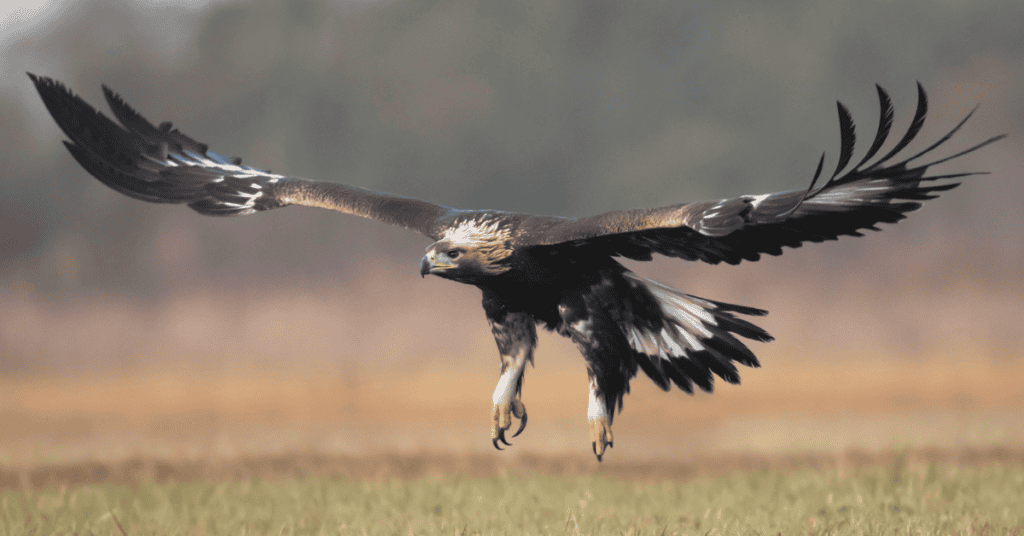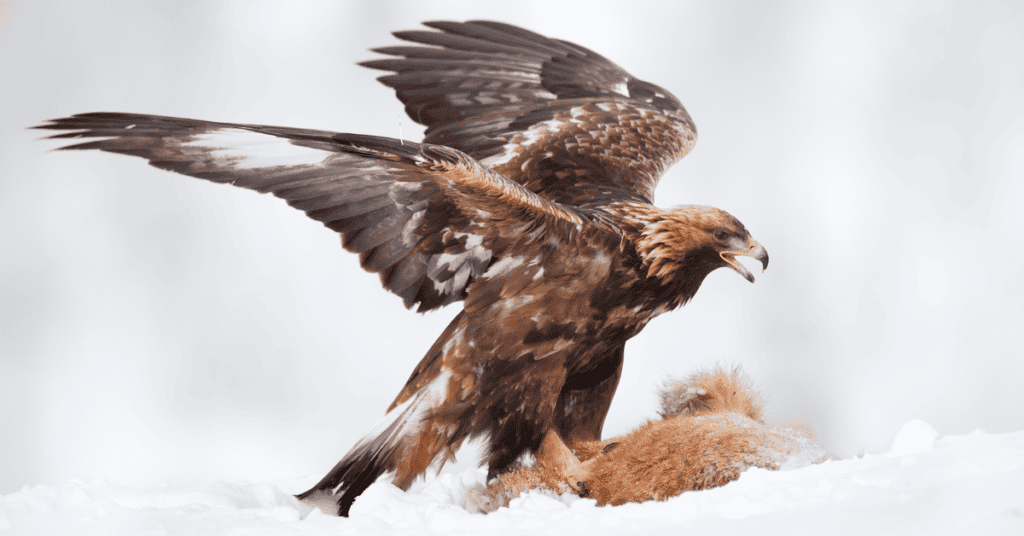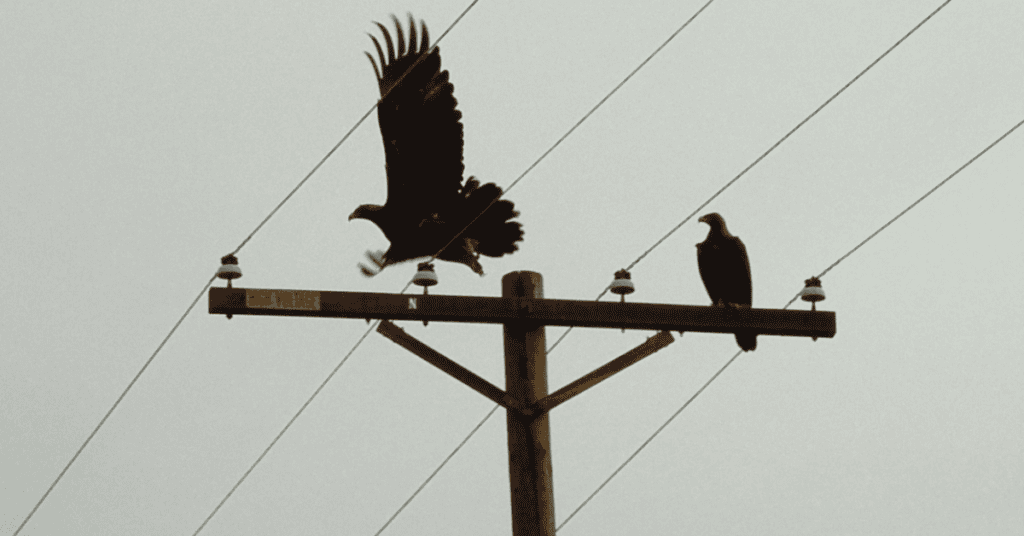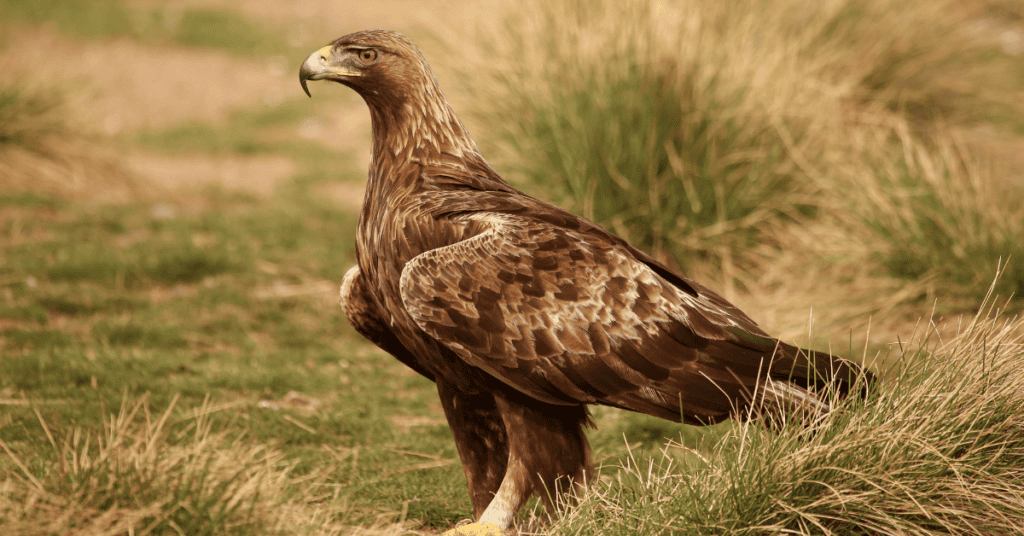Golden eagles are very cool birds of prey that capture your imagination with their power and grace. You may spot these impressive raptors soaring high above mountainous regions or open landscapes across the Northern Hemisphere. Their large size, keen eyesight, and hunting prowess make them true apex predators of the skies.
These magnificent birds have long held cultural significance for many societies throughout history. You’ll find golden eagles featured in myths and legends from ancient civilizations to modern times. Their striking appearance and remarkable abilities inspire awe and admiration in wildlife enthusiasts and casual observers alike.
Largest Bird of Prey in North America

The golden eagle is generally the largest bird of prey in North America. You might be surprised to learn that these huge birds of prey can have a wingspan of up to 7.3 feet!
Their impressive size helps them hunt effectively. You’ll find golden eagles swooping to catch rabbits, ground squirrels, chipmunks, and even larger prey like foxes or young deer.
These powerful raptors weigh between 6 and 13 pounds, with females typically larger than males. You can spot these Eagles soaring high in the sky, using their keen eyesight to locate potential meals.
From Alaska to Mexico, you’ll mainly see Golden eagles in western North America. You’ll likely see them in areas like prairies, tundra, and mountainous regions.
Amazing Eyesight Enables Spotting Prey From Miles Away

Golden eagles possess genuinely remarkable vision. Their eyes are specially adapted to spot even the slightest movements from incredible distances. You might be surprised to learn that a golden eagle can detect a rabbit from over a mile away!
These birds have eyes that are proportionally much more prominent than humans in relation to their body size. The large eyes allow them to take in more visual information. Their retinas also contain more light-sensitive cells called cones, giving them sharper color vision and the ability to see UV light.
Golden eagles can see about 8 times more clearly than the sharpest human vision. This keen eyesight helps them locate prey while soaring high above the landscape. As they scan the ground below, they can spot potential meals like rabbits, hares, and marmots from astonishing heights and distances.
Golden Eagles Mate for Life

Golden eagles form deep, lifelong bonds with their mates—once they pick a partner, they usually stick together until one of them passes on. Did you know that this kind of lifelong monogamy is pretty rare in the animal world? And if you’re wondering how these cool birds choose their partners, watch their courtship rituals.
We saw them pull off elaborate aerial acrobatics and even exchange little gifts during one hiking trip. Apparently it was all part of creating a connection that’s built to last a lifetime.
Golden eagle pairs really work together when it comes to building and looking after their nests. They take turns incubating the eggs and caring for their chicks, a routine that strengthens their bond over time.
Even when they’re not in breeding mode, these birds stick together—they hunt, roost, and even migrate as a pair, proving that their partnership isn’t just for the season.
Powerful Talons Can Exert 750 Psi Pressure
Golden eagles possess powerful talons that exert up to 750 pounds per square inch (psi) of pressure. To put this in perspective, that’s about three times the grip strength of an adult human hand.
These powerful talons allow golden eagles to capture and hold onto prey much more significant than themselves. Some have said they can lift animals weighing up to 8 pounds off the ground, but this has not been proven.
The eagle’s talons are sharp and curved, designed for gripping and piercing. This impressive grip strength helps them maintain hold of struggling prey during flight. It also enables them to crush the bones of smaller animals quickly and efficiently.
They Can Reach Speeds Over 150 Mph During Dives
Golden eagles are incredible aerial predators with remarkable diving speeds. When hunting, you might see them plummet from great heights at astonishing velocities.
These majestic birds can reach speeds exceeding 150 mph during their steep dives, known as stoops. The speed makes them one of the fastest animals on Earth.
You’d be amazed to learn that golden eagles use these high-speed dives to catch prey. If you birdwatch, you can see how their streamlined bodies and mighty wings allow them to achieve these impressive speeds.
As they descend, you’ll notice their wings tucked close to their bodies to reduce air resistance. This aerodynamic posture helps them maintain control while diving at breakneck speeds.
Golden Eagles Build Massive Nests Called Eyries

Golden eagles construct impressive nests known as eyries. You might be amazed that these structures can reach up to 8 feet wide and 3 feet deep.
The eagles carefully select high, inaccessible locations for their eyries. You’ll often find them on cliff edges or in tall trees.
These birds are dedicated builders, adding to their nests year after year. You’d be surprised to see how some eyries can weigh over a ton after decades of use.
Golden eagles use a variety of materials to craft their homes. Sticks form the base, while softer grass, moss, and feathers line the interior.
Building an eyrie is a team effort. You’ll observe male and female eagles working together to create and maintain their nest.
Can Live Up to 30 Years in the Wild

Golden eagles can live a surprisingly long time out in the wild—sometimes up to 30 years. Their longevity really speaks to how tough and adaptable they are. We love watching them year in and year out!
Factors contributing to their lengthy lives include their position at the top of the food chain and their ability to avoid most predators. You’ll find that golden eagles in protected areas tend to live longer due to reduced human interference.
While 30 years is the upper limit, the average lifespan of a Golden Eagle in the wild is typically between 15 to 20 years. Captive golden eagles often live even longer, sometimes reaching 40 years or more.
Diet Includes Mammals, Birds, and Reptiles

Golden eagles have a diverse diet that includes a variety of prey. These majestic birds are hunting small to medium-sized mammals like rabbits, hares, and ground squirrels.
Birds also make up a significant portion of their menu. Golden Eagles will catch and eat grouse, pheasants, and even other raptors when the opportunity arises.
Reptiles aren’t safe from these mighty hunters either. You might spot a golden eagle snatching snakes or lizards, especially in arid regions with abundant prey.
Their diet and food choices can vary depending on the season and available food sources in their habitat. You’ll notice golden eagles adapting their hunting strategies to target the most plentiful prey in their area.
Often Seen Soaring in Mountainous Regions
You’ll often spot golden eagles soaring above mountainous landscapes in the West. These majestic birds thrive in rugged terrain, using updrafts and thermals to glide through the air effortlessly.
Golden eagles prefer open habitats with steep cliffs and rocky outcrops. You might see them circling high above mountain ranges, scanning for prey with their keen eyesight.
We love how their large wingspan, typically between 6 to 7.5 feet, allows them to ride air currents with minimal energy expenditure. This adaptation makes them ideally suited for life in mountainous regions.
I was hiking when I saw my first pair, and it was an impressive sight. If you are lucky, you may also witness their awe-inspiring aerial displays as they soar through the sky.
Famous for Their Distinctive Dark Brown Plumage and Golden Crown
The Golden Eagles have a look that’s hard to miss. Their dark, majestic feathers give them an undeniably regal presence, while a splash of golden on their crown and nape adds a striking contrast. This unique detail isn’t just for show—the very feature that earned them their name. A splash of lighter feathers contrasts beautifully with their darker plumage, earning them their name.
Young golden eagles will have white patches on their wings and tail. As they mature, these patches gradually disappear, leaving the adult birds with their characteristic dark brown coloration.
Their sharp, curved beaks and piercing eyes add to their fierce appearance. You might also spot their impressive talons, which they use for hunting and gripping prey.
Habitat and Range
Golden eagles roam the wide-open spaces of the Northern Hemisphere. You can spot them everywhere—from rugged mountains and endless grasslands to arid deserts and thick forests.
Natural Environment
Golden eagles thrive in rugged terrains with ample hunting grounds. You’ll often spot them soaring above mountainous regions, rolling hills, and open plains. These birds prefer areas with cliffs or tall trees for nesting.
In North America, golden eagles favor the western states and provinces. You might see them in the Rocky Mountains or the Great Basin Desert.
Their ideal habitat includes a mix of open hunting areas and secluded nesting spots. Golden eagles build their massive nests, called eyries, on cliff ledges or in large trees.
Geographical Distribution
You can find golden eagles across a wide range of the Northern Hemisphere. Their distribution spans North America, Europe, and Asia.
In North America, these birds are most common in the western regions. You’ll see them from Alaska down to Mexico, with some populations in eastern Canada.
Europe hosts golden eagles from Scotland to the Mediterranean. In Asia, their range extends from Russia through Central Asia and into parts of China and Japan.
Golden eagles are less common in heavily forested or densely populated areas. You’re more likely to encounter them in remote, mountainous regions or vast expanses of open country.
Distinctive Features of the Golden Eagle
You’ll easily recognize a golden eagle by its dark brown plumage and the golden-brown feathers on its head and neck. These feathers give the bird its name and create a striking appearance.
Their eyes are a piercing yellow-brown, providing exceptional vision for spotting prey from great distances. Golden eagles have a sharp, hooked beak perfect for tearing flesh.
Their legs are feathered all the way to the toes, distinguishing them from other eagle species. (Some refer to them as “booted Eagles” because of this feature. You’ll notice their powerful talons, exerting up to 750 pounds per square inch of pressure.